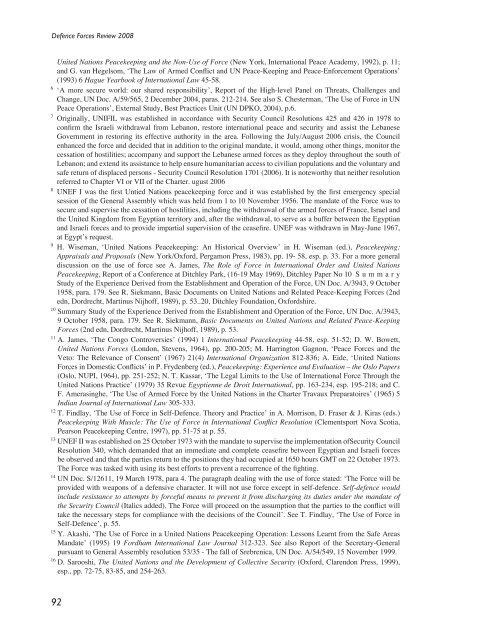Defence Forces Review 2008
Defence Forces Review 2008
Defence Forces Review 2008
You also want an ePaper? Increase the reach of your titles
YUMPU automatically turns print PDFs into web optimized ePapers that Google loves.
<strong>Defence</strong> <strong>Forces</strong> <strong>Review</strong> <strong>2008</strong><br />
United Nations Peacekeeping and the Non-Use of Force (New York, International Peace Academy, 1992), p. 11;<br />
and G. van Hegelsom, ‘The Law of Armed Conflict and UN Peace-Keeping and Peace-Enforcement Operations’<br />
(1993) 6 Hague Yearbook of International Law 45-58.<br />
6<br />
‘A more secure world: our shared responsibility’, Report of the High-level Panel on Threats, Challenges and<br />
Change, UN Doc. A/59/565, 2 December 2004, paras. 212-214. See also S. Chesterman, ‘The Use of Force in UN<br />
Peace Operations’, External Study, Best Practices Unit (UN DPKO, 2004), p.6.<br />
7<br />
Originally, UNIFIL was established in accordance with Security Council Resolutions 425 and 426 in 1978 to<br />
confirm the Israeli withdrawal from Lebanon, restore international peace and security and assist the Lebanese<br />
Government in restoring its effective authority in the area. Following the July/August 2006 crisis, the Council<br />
enhanced the force and decided that in addition to the original mandate, it would, among other things, monitor the<br />
cessation of hostilities; accompany and support the Lebanese armed forces as they deploy throughout the south of<br />
Lebanon; and extend its assistance to help ensure humanitarian access to civilian populations and the voluntary and<br />
safe return of displaced persons - Security Council Resolution 1701 (2006). It is noteworthy that neither resolution<br />
referred to Chapter VI or VII of the Charter. ugust 2006<br />
8<br />
UNEF I was the first Untied Nations peacekeeping force and it was established by the first emergency special<br />
session of the General Assembly which was held from 1 to 10 November 1956. The mandate of the Force was to<br />
secure and supervise the cessation of hostilities, including the withdrawal of the armed forces of France, Israel and<br />
the United Kingdom from Egyptian territory and, after the withdrawal, to serve as a buffer between the Egyptian<br />
and Israeli forces and to provide impartial supervision of the ceasefire. UNEF was withdrawn in May-June 1967,<br />
at Egypt’s request.<br />
9<br />
H. Wiseman, ‘United Nations Peacekeeping: An Historical Overview’ in H. Wiseman (ed.), Peacekeeping:<br />
Appraisals and Proposals (New York/Oxford, Pergamon Press, 1983), pp. 19- 58, esp. p. 33. For a more general<br />
discussion on the use of force see A. James, The Role of Force in International Order and United Nations<br />
Peacekeeping, Report of a Conference at Ditchley Park, (16-19 May 1969), Ditchley Paper No 10 S u m m a r y<br />
Study of the Experience Derived from the Establishment and Operation of the Force, UN Doc. A/3943, 9 October<br />
1958, para. 179. See R. Siekmann, Basic Documents on United Nations and Related Peace-Keeping <strong>Forces</strong> (2nd<br />
edn, Dordrecht, Martinus Nijhoff, 1989), p. 53..20, Ditchley Foundation, Oxfordshire.<br />
10<br />
Summary Study of the Experience Derived from the Establishment and Operation of the Force, UN Doc. A/3943,<br />
9 October 1958, para. 179. See R. Siekmann, Basic Documents on United Nations and Related Peace-Keeping<br />
<strong>Forces</strong> (2nd edn, Dordrecht, Martinus Nijhoff, 1989), p. 53.<br />
11<br />
A. James, ‘The Congo Controversies’ (1994) 1 International Peacekeeping 44-58, esp. 51-52; D. W. Bowett,<br />
United Nations <strong>Forces</strong> (London, Stevens, 1964), pp. 200-205; M. Harrington Gagnon, ‘Peace <strong>Forces</strong> and the<br />
Veto: The Relevance of Consent’ (1967) 21(4) International Organization 812-836; A. Eide, ‘United Nations<br />
<strong>Forces</strong> in Domestic Conflicts’ in P. Frydenberg (ed.), Peacekeeping: Experience and Evaluation – the Oslo Papers<br />
(Oslo, NUPI, 1964), pp. 251-252; N. T. Kassar, ‘The Legal Limits to the Use of International Force Through the<br />
United Nations Practice’ (1979) 35 Revue Egyptienne de Droit International, pp. 163-234, esp. 195-218; and C.<br />
F. Amerasinghe, ‘The Use of Armed Force by the United Nations in the Charter Travaux Preparatoires’ (1965) 5<br />
Indian Journal of International Law 305-333.<br />
12<br />
T. Findlay, ‘The Use of Force in Self-<strong>Defence</strong>. Theory and Practice’ in A. Morrison, D. Fraser & J. Kiras (eds.)<br />
Peacekeeping With Muscle: The Use of Force in International Conflict Resolution (Clementsport Nova Scotia,<br />
Pearson Peacekeeping Centre, 1997), pp. 51-75 at p. 55.<br />
13<br />
UNEF II was established on 25 October 1973 with the mandate to supervise the implementation ofSecurity Council<br />
Resolution 340, which demanded that an immediate and complete ceasefire between Egyptian and Israeli forces<br />
be observed and that the parties return to the positions they had occupied at 1650 hours GMT on 22 October 1973.<br />
The Force was tasked with using its best efforts to prevent a recurrence of the fighting.<br />
14<br />
UN Doc. S/12611, 19 March 1978, para 4. The paragraph dealing with the use of force stated: ‘The Force will be<br />
provided with weapons of a defensive character. It will not use force except in self-defence. Self-defence would<br />
include resistance to attempts by forceful means to prevent it from discharging its duties under the mandate of<br />
the Security Council (Italics added). The Force will proceed on the assumption that the parties to the conflict will<br />
take the necessary steps for compliance with the decisions of the Council’. See T. Findlay, ‘The Use of Force in<br />
Self-<strong>Defence</strong>’, p. 55.<br />
15<br />
Y. Akashi, ‘The Use of Force in a United Nations Peacekeeping Operation: Lessons Learnt from the Safe Areas<br />
Mandate’ (1995) 19 Fordham International Law Journal 312-323. See also Report of the Secretary-General<br />
pursuant to General Assembly resolution 53/35 - The fall of Srebrenica, UN Doc. A/54/549, 15 November 1999.<br />
16<br />
D. Sarooshi, The United Nations and the Development of Collective Security (Oxford, Clarendon Press, 1999),<br />
esp., pp. 72-75, 83-85, and 254-263.<br />
92
















